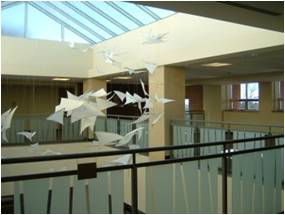The Impact of GSA's High-Performance Buildings
High-performance buildings of the U.S. General Services Administration (GSA) save energy, save water, cost less to operate, produce less waste, and have more satisfied occupants compared with typical buildings. In short, they deliver cost savings and tenant satisfaction.
These are the conclusions drawn from GSA’s recently completed study![]() examining 200 of its federally owned and managed buildings with data from the past three years. Compared to legacy stock buildings, GSA’s high-performance buildings have:
examining 200 of its federally owned and managed buildings with data from the past three years. Compared to legacy stock buildings, GSA’s high-performance buildings have:
- 23% lower energy use,
- 28% lower water use,
- 23% lower building operating expenses,
- 9% less waste landfilled and
- 2% higher overall tenant satisfaction.
Energy and water savings are even greater when compared to industry benchmarks – 43% for energy and 35% for water. Investing to improve building performance presents savings opportunities. If the 100 legacy stock buildings met the average performance rates of high-performance buildings, they could save over $44 million per year.
In this study, high-performance buildings are those that meet the Guiding Principles for Sustainable Federal Buildings![]() , a common set of performance goals for federal agencies to reduce the total cost of owning and operating facilities, while improving resource efficiency and providing safe, healthy, and productive built environments. In this study, legacy stock refers to buildings that have not been upgraded to meet the Guiding Principles.
, a common set of performance goals for federal agencies to reduce the total cost of owning and operating facilities, while improving resource efficiency and providing safe, healthy, and productive built environments. In this study, legacy stock refers to buildings that have not been upgraded to meet the Guiding Principles.
GSA’s mission is to deliver value and savings in real estate, acquisition, technology, and other mission-support services across government – in short, to enable effective and efficient government for the American people. GSA is committed to providing safe, healthy, and productive workplaces for federal workers at the best value for the American taxpayer. High-performance buildings are an essential element supporting this commitment.
As the single largest owner/operator of office space in the United States, GSA controls over 370 million rentable square feet including office buildings, courthouses, land ports of entry, and warehouses. Within GSA’s owned portfolio, high-performance buildings comprise 27% of buildings and 40% of gross square feet.
Executive Order 14057![]() , Executive Order on Catalyzing Clean Energy Industries and Jobs Through Federal Sustainability
, Executive Order on Catalyzing Clean Energy Industries and Jobs Through Federal Sustainability![]() , requires agencies to report on performance improvements and cost reductions – including energy and water savings. This study’s findings demonstrate the sustained value of high-performance buildings as part of the federal government’s building portfolio.
, requires agencies to report on performance improvements and cost reductions – including energy and water savings. This study’s findings demonstrate the sustained value of high-performance buildings as part of the federal government’s building portfolio.
GSA will leverage the results of this study to promote cost savings, technology advancement, and operational excellence in our nation’s federal buildings. These findings can help federal, state, and local agencies understand the benefits of tracking and reporting building performance data. The resulting data can be used to drive portfolio-level decisions – and save money.
Related Topics
Building Performance
Building performance can be measured against various environmental and economic attributes. A key to evaluating building performance is establishing a common set of measurements to be used. Sustainable building standards often consider environmental performance in categories including, energy, water, indoor environmental quality, materials use, waste management, as well as economic performance, such as life-cycle costs.
Guiding Principles for Sustainable Federal Buildings![]()
TechStreet.com | ASHRAE’s Performance Measurement Protocols![]()
Energy Efficiency
Energy efficiency is a comparison of the amount of energy used compared to the amount of output produced. In the built environment, this means using the least amount of energy (electricity, natural gas, etc.) to operate a facility appropriately. Steps that can help a building run efficiently include: ensuring there are no air leaks, using sensors or timers to ensure the building isn’t operating when vacant, and using energy-efficient equipment.
Energy Performance
Assessing a building’s energy performance involves comparing its energy use to that of peers or a standard. The ENERGY STAR program provides recognized benchmarks for assessing a building’s energy performance.
Guiding Principles for Sustainable Federal Buildings
The Guiding Principles for Sustainable Federal Buildings and Associated Instructions are a set of sustainable principles for integrated design, energy performance, water conservation, indoor environmental quality, materials, and resilience aimed at helping Federal agencies and organizations:
- Reduce the total ownership cost of facilities
- Improve energy efficiency and water conservation
- Provide safe, healthy, and productive built environments
- Promote sustainable environmental stewardship
Guiding Principles for Sustainable Federal Buildings and Associated Instructions
Waste Diversion
Waste diversion is the process of diverting waste from the landfill. Waste in landfills and incinerators create greenhouse gas emissions that contribute to climate change. Ways to increase waste diversion include recycling, reusing, and source reduction.
Water Conservation
Over 400 billion gallons of water are used every day in the United States. Demand is increasing even though usable supply is decreasing. Civilian agencies in the federal government use 47 billion gallons of water per year, the equivalent of more than 70,000 Olympic-size swimming pools. These agencies could save 7.8–12.3 billion gallons (17–26%) annually just by using simple “off the shelf” water conservation measures, including replacing existing toilets, faucets, and showerheads with more efficient versions.
GSA | Indoor Water Conservation![]()
DOE | Developing a Water Management Plan![]()
DOE | Guidance for the Implementation and Follow-up of Identified Energy and Water Efficiency![]()

